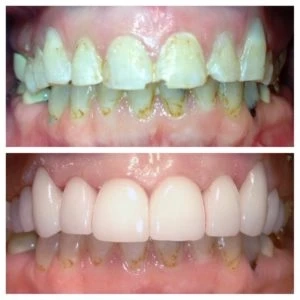In the realm of cosmetic dentistry, veneers play a pivotal role in transforming smiles and boosting confidence. Veneers are thin, custom-made shells designed to cover the front surface of teeth, enhancing their appearance and addressing various cosmetic concerns. This guest post will explore the role of veneers in cosmetic dentistry, detailing their benefits, the process of getting them, and how they contribute to a comprehensive approach to smile enhancement.
What Are Dental Veneers?
Dental veneers are ultra-thin coverings made from porcelain or composite resin. They are designed to bond to the front surface of teeth, effectively masking imperfections such as discoloration, chips, gaps, and misalignments. Porcelain veneers are known for their durability and natural appearance, while composite resin veneers offer a more affordable and versatile option. Both types are tailored to meet individual aesthetic goals, providing a customized solution for enhancing the smile.
The Benefits of Veneers
- Aesthetic Improvement
The primary benefit of veneers is their ability to dramatically improve the appearance of teeth. Veneers can effectively address a range of cosmetic issues, including:
- Stains and Discoloration: Veneers can cover teeth that have become stained or discolored over time, especially when traditional whitening treatments are ineffective.
- Chips and Cracks: They provide a smooth and uniform surface, concealing minor chips and cracks.
- Gaps and Misalignments: Veneers can mask gaps between teeth and create the illusion of a straighter smile without the need for orthodontics.
- Durability and Longevity
Porcelain veneers, in particular, are known for their strength and longevity. Made from high-quality ceramic materials, they are resistant to staining and can last between 10 to 15 years with proper care. Composite resin veneers are less durable but still offer a reliable option for those seeking a more cost-effective solution. Regular dental checkups and good oral hygiene can significantly extend the lifespan of both types of veneers.
- Minimal Tooth Alteration
Compared to other cosmetic procedures, veneers require minimal alteration of the natural tooth structure. The process typically involves removing only a thin layer of enamel to accommodate the veneer, preserving most of the natural tooth. This conservative approach is less invasive than treatments that require more extensive tooth reduction or restructuring.
- Quick and Effective Results
Veneers offer a fast and efficient way to achieve a stunning smile. The entire process, from the initial consultation to the final placement of veneers, is often completed in just a few visits. This quick turnaround makes veneers an appealing option for individuals looking to enhance their smile in a relatively short period.
- Natural-Looking Results
Veneers are designed to mimic the natural translucency and color of teeth, resulting in a seamless and lifelike appearance. Porcelain veneers, in particular, are highly effective at reflecting light and blending with the natural teeth, ensuring that the final result looks both beautiful and natural.
The Process of Getting Veneers
- Initial Consultation
The journey to a perfect smile with veneers begins with an initial consultation with a cosmetic dentist. During this visit, the dentist will assess your oral health, discuss your aesthetic goals, and determine if veneers are a suitable option for you. They may take X-rays and digital impressions to plan the treatment and design the veneers.
- Tooth Preparation
If veneers are deemed appropriate, the next step involves preparing your teeth. This process typically includes removing a small amount of enamel from the front surface of the teeth to create space for the veneers. This minimal preparation ensures that the veneers fit properly and look natural. Impressions of your teeth are then taken and sent to a dental lab where the custom veneers will be created.
- Temporary Veneers
While your permanent veneers are being made, the dentist may provide you with temporary veneers. These temporary veneers protect your teeth and give you a preview of your new smile. They are designed to be comfortable and functional until your final veneers are ready.
- Final Placement
Once your permanent veneers are ready, you’ll return to the dentist for the final placement. The dentist will check the fit, color, and shape of the veneers to ensure they meet your expectations. The veneers are then bonded to your teeth using a special adhesive. Any necessary adjustments will be made to ensure a perfect fit and finish.
- Aftercare and Maintenance
After the placement of your veneers, the dentist will provide you with instructions on how to care for them. This includes maintaining good oral hygiene practices, avoiding staining foods and beverages, and scheduling regular dental checkups. Proper care is essential for ensuring the longevity and effectiveness of your veneers.
The Role of Veneers in Comprehensive Cosmetic Dentistry
Veneers are a versatile tool in cosmetic dentistry, offering a range of benefits and solutions for enhancing smiles. They play a crucial role in addressing aesthetic concerns and complementing other cosmetic procedures. For example, veneers can be combined with teeth whitening, orthodontics, or dental implants to achieve a comprehensive smile makeover. This holistic approach ensures that all aspects of your smile are addressed, resulting in a harmonious and attractive outcome.
Conclusion
Dental veneers are a valuable option in cosmetic dentistry, providing an effective and aesthetically pleasing solution for a variety of cosmetic issues. Their benefits, including aesthetic improvement, durability, minimal tooth alteration, and natural-looking results, make them a popular choice for those seeking to enhance their smile. By understanding the process and role of veneers, you can make an informed decision and work with a skilled cosmetic dentist to achieve the smile of your dreams. Whether used alone or in conjunction with other treatments, veneers contribute significantly to the art and science of cosmetic dentistry, offering patients a path to a confident and radiant smile.


